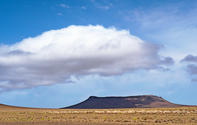Breathe Deeply
There's a symmetry in the air around you that is beautiful, poetic, invisible and entirely underrated. 78 percent of each breath you draw is nitrogen, diluting the 21 percent oxygen content that keeps you conscious and functioning, along with a smattering of water vapour, carbon dioxide, carbon monoxide, methane, helium, argon, neon and a few other gases.

If there were a fraction more oxygen in the gaseous cocktail, you would not be sitting so contentedly. If we did not have the fraction of carbon dioxide (0.037 per cent of the total) wrapped around our planet like a shawl, life as we know it would not have stood a chance in a frozen wasteland.
There's a minute amount of ammonia too. Every time lightning slices through the sky, it causes a chemical reaction in the atmosphere as nitrogen and oxygen combine to form nitrous acid. Without the alkaline effect of ammonia to neutralise the acid, the biosphere would slowly scorch itself to death.
The ridiculously thin layer of ozone at 20 to 25 km4 up, keeps us all from being baked in our skins and our cells from being mutated by DNA-scrambling ultraviolet light.
Breathable Atmosphere

After 4 600 million years, an atmosphere has evolved in such glorious and unlikely equilibrium that it makes me want to breathe a little deeper on the deliciously tasteless stuff. Throughout your lifetime you will suck in around 250 million litres of air as you go about the business of living.
In that time, you may occasionally want to ponder on this: just how unlikely is it that the 'third planet from a minor star' enjoys a series of physical characteristics that achieved a breathable atmosphere, one in which billions of years of evolution produced a species that adapted the world around it so masterfully that it could escape that very atmosphere in a chunk of flying metal controlled by messages conveyed in a binary code of 0s and 1s?
By Leonie Joubert